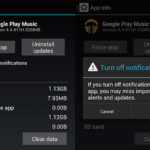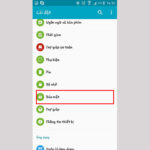Before learning how to control air conditioners with a phone, there are some important considerations you should take into account to ensure a more effective and safer experience.
Some notes when using a phone to control air conditioners
/fptshop.com.vn/uploads/images/tin-tuc/167968/Originals/cach-dieu-khien-dieu-hoa-bang-dien-thoai_5.jpg)
In reality, not all smartphones have the ability to control air conditioners. Therefore, users need to do thorough research and make sure that their smartphones meet specific criteria. Here are some things you need to consider before attempting to connect and control an air conditioner from your phone:
Compatibility with the operating system
For remote control apps, make sure that they are compatible with your phone’s operating system (Android or iOS).
- Android operating system: For phones running on this operating system, make sure to update to the latest version.
- iOS operating system: In order to control the air conditioner, phones running on this operating system need to upgrade to iOS 7.0 or higher.
Support for Wifi and Bluetooth connectivity
First and foremost, you need to make sure that your air conditioner has the ability to connect to Wifi or Bluetooth networks. Most remote control apps use these connections to communicate with the device.
Smart integration
Check if the device supports platforms like Google Assistant, Amazon Alexa, or Apple HomeKit.
Updating firmware/software
Sometimes, in order to use new features, you need to update the firmware of the air conditioner. Check if there are any new software updates available and perform the update if necessary.
If your device meets the above requirements, you can easily connect and control the air conditioner from your phone.
How to control air conditioners with an Android phone
/fptshop.com.vn/uploads/images/tin-tuc/167968/Originals/cach-dieu-khien-dieu-hoa-bang-dien-thoai_6(1).jpg)
Generally, the most popular app used to turn on air conditioners with an Android phone is Mi Remote Controller. This app allows phones running on the Android operating system to easily control air conditioners remotely with similar features to an actual remote. Here’s how to control air conditioners with an Android phone.
Step 1: Download the Mi Remote Controller app from Play Store on your phone. Open the app → Add Control (the plus sign icon in the top left corner).
/fptshop.com.vn/uploads/images/tin-tuc/167968/Originals/cach-dieu-khien-dieu-hoa-bang-dien-thoai_1.jpg)
Step 2: Select the air conditioner device icon. Then, a list of air conditioners will appear → Select the brand of your air conditioner.
/fptshop.com.vn/uploads/images/tin-tuc/167968/Originals/cach-dieu-khien-dieu-hoa-bang-dien-thoai_2.jpg)
Step 3: In the new device search interface → Select the name of the air conditioner you want to connect → Press the blue icon in the middle to connect. Monitor if your air conditioner is truly connected to the phone by:
- Hearing the “BEEP” sound: You have successfully connected → Select “Yes” to proceed to the next step.
- No “BEEP” sound: The phone is not connected to the air conditioner → Select “No” → Continue searching for the air conditioner code and repeat the steps above until you hear the “BEEP” sound.
/fptshop.com.vn/uploads/images/tin-tuc/167968/Originals/cach-dieu-khien-dieu-hoa-bang-dien-thoai_3.jpg)
Step 4: After the air conditioner and phone have successfully connected, rename the device → Select “Paired”.
That’s it for the content on how to control air conditioners with an Android phone. You can use the control panel on the app similar to an actual air conditioner remote. Bookmark and try it out right away. Good luck!
Top 10 apps for controlling air conditioners with a phone
Below are some popular air conditioner control apps on Android, along with their advantages and disadvantages.
1. Tado°
Advantages: User-friendly interface, integration with smart platforms, smart temperature adjustment based on your location.
Disadvantages: May require special Tado devices to fully utilize all the features.
2. Sensibo
Advantages: Flexible, supports various types of air conditioners, integrates smart sensors.
Disadvantages: Some features require paid service subscriptions.
3. Broadlink e-Control
Advantages: Supports multiple electronic devices, flexible, and has the ability to learn commands from the original remote.
Disadvantages: Not a very user-friendly interface and may be complex.
4. SmartThings
Advantages: Integrates multiple smart devices, supports Google Assistant and Amazon Alexa platforms.
Disadvantages: Sometimes requires the use of the Samsung SmartThings hub.
5. AC Remote Control (AC Universal Remote)
Advantages: Supports multiple air conditioner brands, simple interface.
Disadvantages: Advertisements may be annoying.
6. AnyMote Universal Remote
Advantages: Supports multiple devices, customizable, and can learn new commands.
Disadvantages: Contains advertisements in the app.
7. Remotec Universal Remote
Advantages: User-friendly interface, supports multiple devices, integrates a learning function.
Disadvantages: Advertisements may be annoying.
8. Xiaomi Mi Remote
Advantages: Pre-installed on some Xiaomi devices, easy to use.
Disadvantages: Limited support for non-Xiaomi devices.
9. SURE Universal Remote
Advantages: Supports multiple devices, integrates voice control feature.
Disadvantages: May have compatibility issues with some devices.
10. Cielo Home
Advantages: Beautiful interface, integrates many smart features, supports voice platforms.
Disadvantages: Some features require account registration and connection to the Cielo control center.
Conclusion
With the simple method of controlling air conditioners with an Android phone mentioned above, you can easily control air conditioners without a remote. Bookmark it and give it a try. Best of luck!
Top 5 Air Conditioner Remote Control Apps for Smartphones in 2021
With the emergence of modern technology, air conditioning can now be strengthened through your smartphone. No remote control required! In this article, we have sourced out and presented the most efficient and top-rated apps for controlling your air conditioner, applicable for both Android and iOS phones.






































